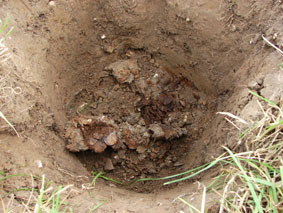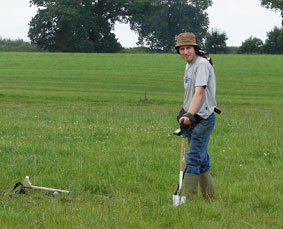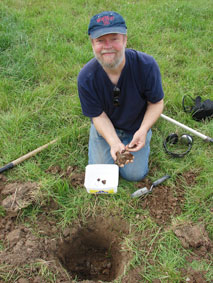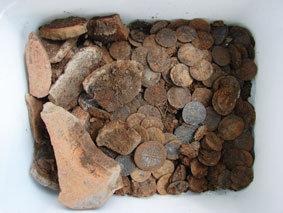William I |
Edward II |
||
William II |
Henry VIII |
||
Henry I |
Edward VI |
Anne |
|
Henry IV |
George I |
||
George II |
|||
Richard I |
|||
Edward IV |
|||
Edward V |
Cromwell |
William IV |
|
Richard III |
|||
A genuine hoard, at last...
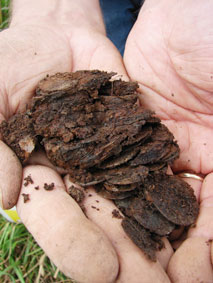
July 26th 2008, near Dorchester Recently I finished co-writing a book on the domestic use of polytunnels (or 'hoophouses') which is due out in the Spring of 2009. I wrote it with a good friend, Andy, who is also a keen detectorist - in fact not too long ago he bought my old XLT from me. We had agreed to go and take some photos of a nearby polytunnel that's used for livestock (rather than growing veggies), after which we headed off to one of our fave detecting sites. After about 20 minutes I found my first coin, an Edward III halfgroat. The ground was quite hard despite the 'orrible weather we've had this 'summer', as I believe it's called, and unfortunately I managed to bend one edge very slightly with the spade. Mentally cursing my stupidity I walked over to where Andy was thrashing about at some long-ish grass to show him the find. Off I went again, and within a few more minutes I found another coin, this time an Edward III penny. Wow, I thought to myself, two coins! This is turning out to be a really GOOD day - and if I hadn't found anything else at all I would have been very happy with that as a result. However, after only a couple more minutes I got a third signal that sounded just like the other two. Amazing, I thought to myself as I started to dig, three coins in 15 minutes! I dug it out (another Ed III penny), filled in the hole and turned to walk away - but as I did so, the head of the detector swung over the findspot...and bleeped again. Right then I knew I'd found something special. After all, you just don't get two coins in the same hole...but you may get 50! Or even 100! I kept on digging, and out came another coin.
This time I didn't fill in the hole, but swung the detector yet again - and got another bleep. And then another. And another. Within a few minutes I'd dug 5 coins out of the same hole, and the signal just kept getting better and better. It just had to be a hoard. I decided to dig the hole out to widen it so that nothing (else!) was damaged. Then, I pushed the spade down at the side of the hole, and pulled gently. It was like lifting the lid off a pot - and there underneath it was a pile of coins, staring me in the face.
'Andy!', I yelled. 'What have you found?' he shouted back. I just stood there for a moment, unable to find the words. 'Come and see!', I managed to blurt, and, realising that it must be something special, he immediately headed towards me. We both stared into the hole. 'My god', muttered Andy, 'there must be 40 coins there...'. An optimistic view, at the time - but in fact it proved to be a long way short of the final total. Fortunately, my camera was in the car. We headed back toward the farmhouse to get it, and to let the farmer know. Having passed on our news, and with the camera and a very optimistically-sized tupperware tub in hand, we walked back to the field to do some serious excavating.
In fact, digging out a hoard is neither quick nor easy, and it took us pretty much the rest of the day. The hole was widened out to roughly 4ft, and then carefully detected. Using the pinpoint setting we found two quite large areas of 'continuous bleep' and many other individual signals scattered around them. As each lump of earth emerged we'd carefully detect it and pull out whatever was inside. When we eventually stopped for lunch, I sat beside the hole eating a sandwich while I removed coins from a clod of earth beside me. By the time the sandwich had gone, I had added 27 coins to the pot. No problem, I thought. I can do this all day if I have to. Sure, it's a tough job, but what to do? Finally, we re-filled the hole. The last coin to come out of it was a very nice-looking groat, which put the icing on the cake as far as I was concerned. The total count was 292 coins, mostly pennies but with a fair scattering of groats and halfgroats. As far as I could tell they were either Edward III or Richard II, but there were a few that appeared to be Edward I as well. There were also fragments of a pot which, according to the Finds Liaison Officer were actually from two pots - so maybe there were two hoards, side by side. As a plough had broken the pots at some point, the scattering was fairly complete by the time I found them, but there were definitely both Edward and Richard coins in both the large coin-clumps.
The whole lot, including pot fragments and a few small and very thin pieces of glass, is now up at the British Museum being recorded. I very politely asked that if there were any Richard III coins, might I have them back? Alas, the immediate reply was 'you'll never see them again...'. I'll update this page as soon as I hear more, which I'm told is likely to take around 4 months - at which point I should receive a list of what exactly was found. Eventually, either the whole lot will be returned, or, if not, the value will be divided between the farmer and myself. Oh, and I'll buy Andy a beer...
|
Back to top
Home |
Collection |
Cartoons |
Stories |
